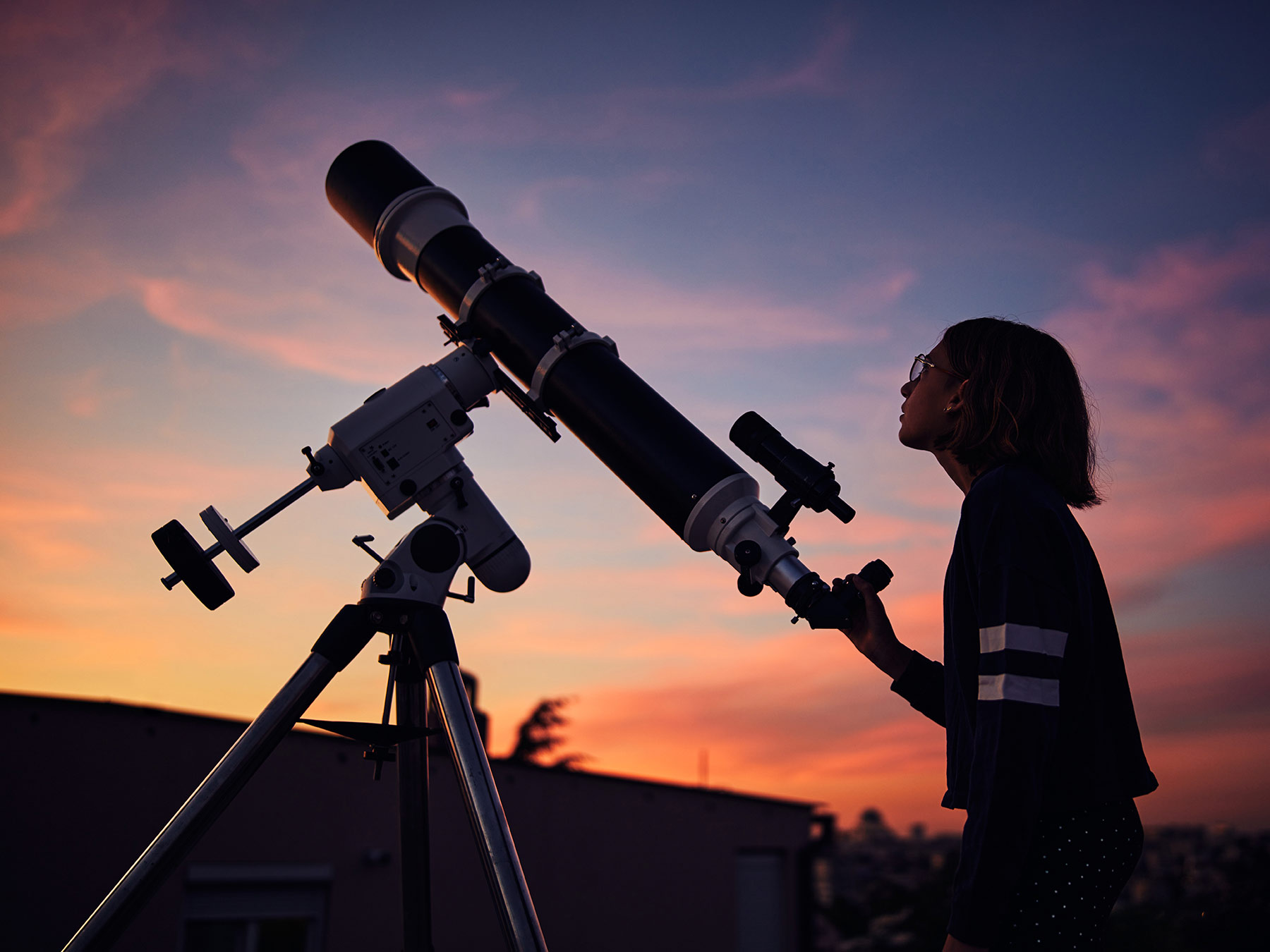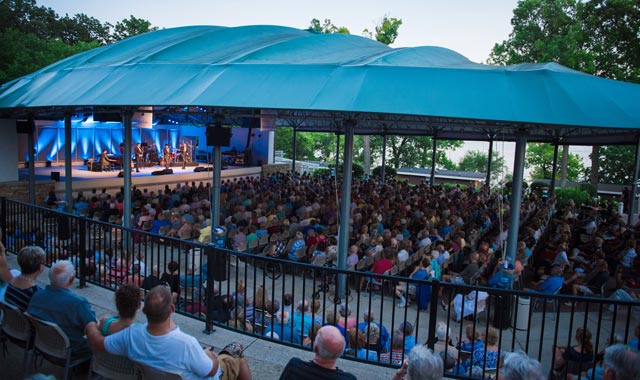Whether you’re a seasoned astronomer or just a casual stargazer, there’s plenty to see in our night sky. These three hot spots are a good place to start.
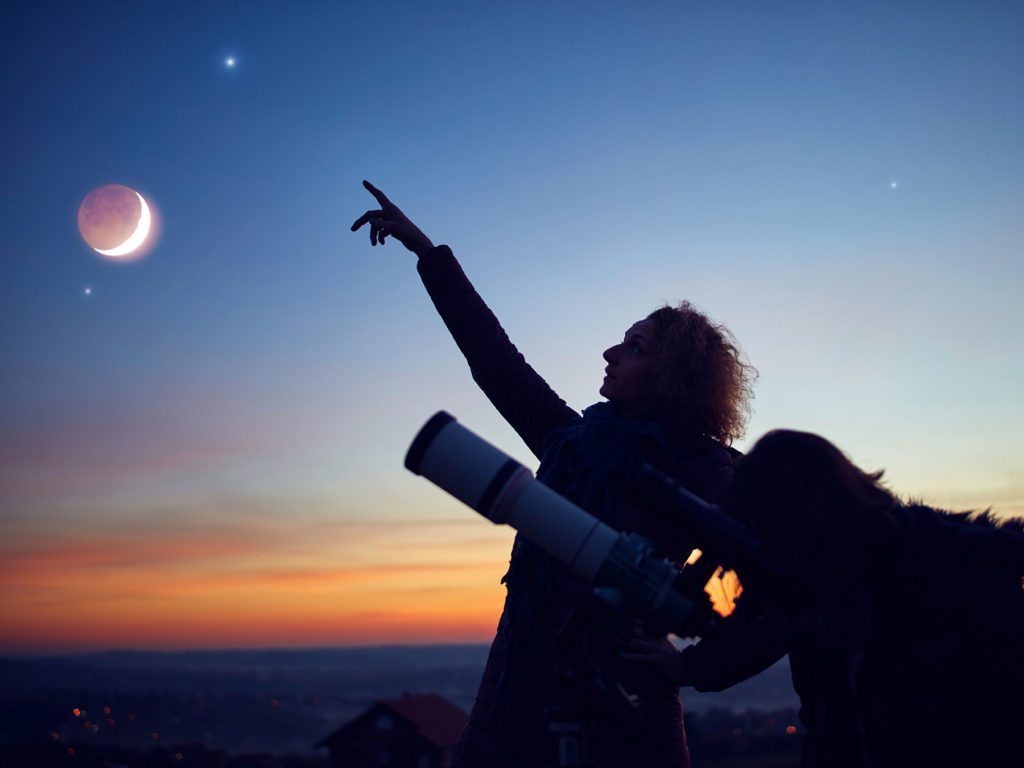
Our region is filled with natural beauty and breathtaking wonders but sometimes, if we truly want to be inspired, the best place to look is up.
Humankind has looked to the night sky since the very beginning. Myths and legends were created around its constellations. Explorers and sailors used it to navigate their way through unknown lands and waters. For centuries, astronomers have looked into the vast world beyond our own, discovered new celestial bodies, recorded phenomena and slowly but surely unraveled the infinite mysteries that always seem to be just beyond our reach.
Whether you’re a seasoned astronomer or a casual observer, the stargazing opportunities in our region are many and varied. From historically significant observatories to quiet spaces with suitably dark skies, our expansive skies offer a captivating chance to explore the wonders of the cosmos.
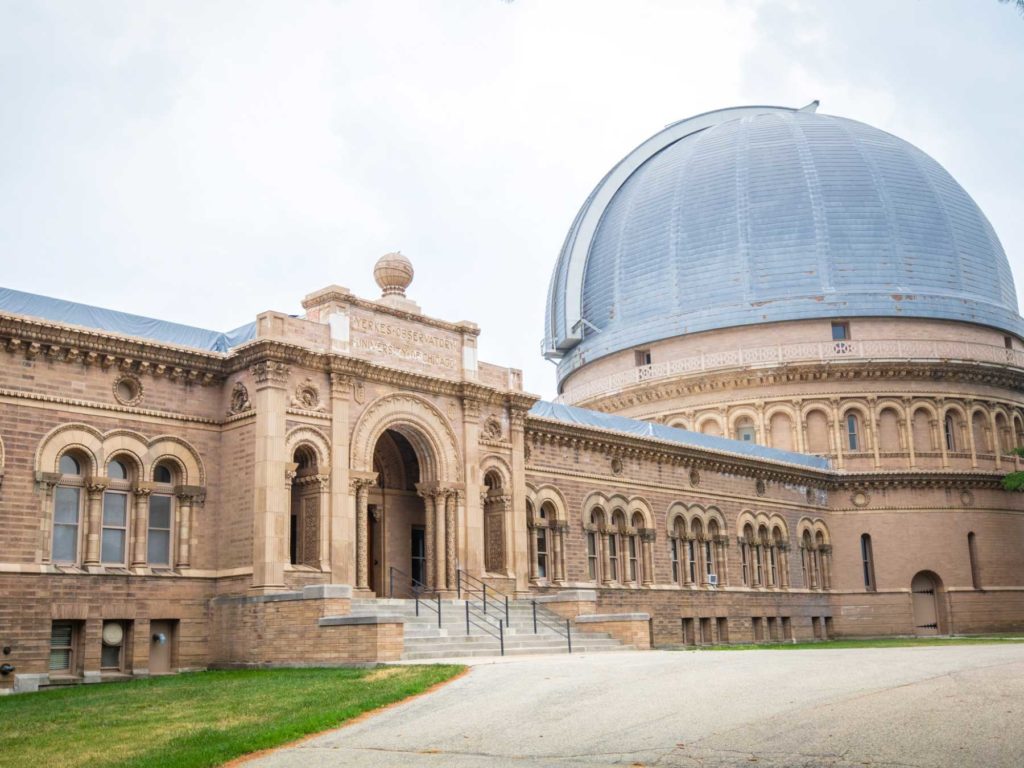
Yerkes Observatory
Since 1897, Yerkes Observatory has been an icon in the world of astronomy, welcoming many stars of the science world to view the celestial ones through the telescopes.
George Ellery Hale, Edwin Hubble and Carl Sagan have all worked at the Williams Bay, Wis., observatory, located off the northwest corner of Geneva Lake. Albert Einstein also paid a visit. Sherburne W. Burnham catalogued almost 14,000 star systems with the observatory’s Great Refractor, the largest refracting telescope in the world. Yerkes is where Nancy Grace Roman did her graduate work before she became NASA’s first chief of astronomy. It’s also the birthplace of modern astrophysics, a branch of science that employs the principles of physics to understand celestial bodies. The observatory’s founder, George Ellery Hale, was a pioneer in this field and did much of his essential work at Yerkes.
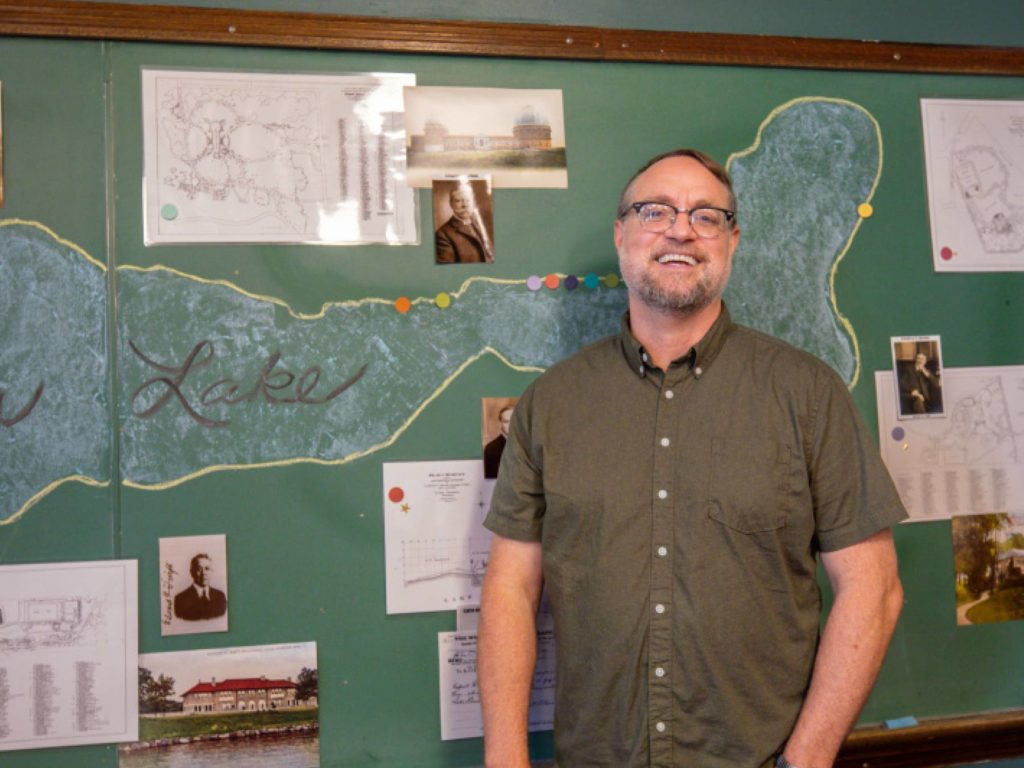
“We’re doing things that people in 50 to 100 years will be talking about,” says Walt Chadick, Director of Programs & External Affairs at Yerkes Observatory.
The legacy of Yerkes extends far beyond astronomy. Its architecture and landscape have also made a mark on history. The building itself combines Beaux Arts and Romanesque styles and was designed by Henry Ives Cobb, who also designed the Newberry Library in Chicago, the original University of Chicago campus and Liberty Tower in New York City. The 50 acres of surrounding landscape were originally planned by the Olmsted Brothers, sons of the same Frederick Law Olmsted who designed New York’s Central Park. To get to the observatory’s telescopes, you need to rise 23 feet on the largest indoor elevator in the world.
“It’s 74,000 pounds controlled by a Thomas Edison DC motor,” says Chadick. “Using it never gets old.”
Currently, visitors can tour Yerkes during the day for a variety of architecture and landscape tours, including a Hidden Spaces tour where visitors can climb winding staircases and duck under pipes to get a behind-the-scenes look at some of the places where renowned astronomers did their work.
Stargazers should check yerkesobservatory.org for its Night at the Observatory evenings, typically held on Friday nights.
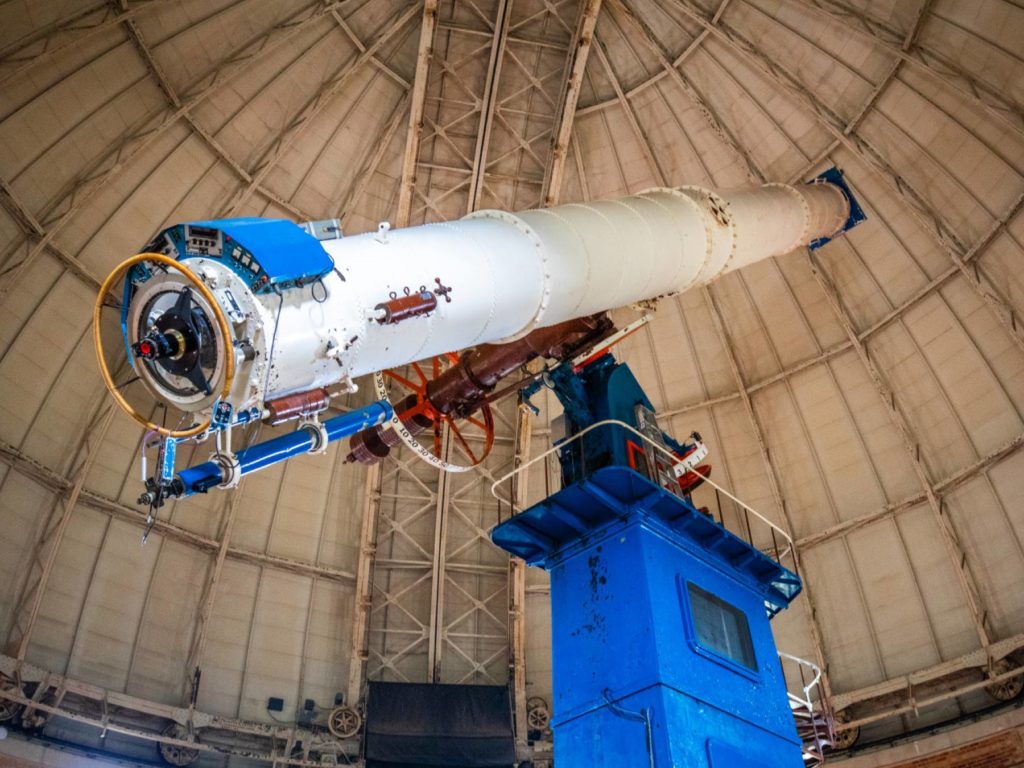
“If the sky is clear, then it’s likely that we’ll be looking through some telescopes,” says Dr. Amanda Bauer, Montgomery Foundation Deputy Director and head of science and education for Yerkes Observatory.
If the sky is not clear, Bauer promises visitors a glimpse of the nearly 180,000 glass plate photographs that astronomers have captured from Yerkes’ historic equipment, which is also on display.
“The plates give a really unique view of the history of astronomy,” says Bauer. “You can see anything from the planets in our solar system to some of the most distant galaxies that we could see at that time.”
A trip to Yerkes gives visitors a chance not only to see astronomy in action but to also witness the discipline’s evolution.
“Yerkes observatory has really led the way in how we capture astronomical data,” says Bauer.
This evolution is especially evident through the observatory’s three telescopes, starting with its Great Refractor, a 6-ton, 64-foot-long refracting lens telescope that traces its start to a pair of glass lenses in the 1890s. The other two are reflecting telescopes built in the 1960s. Now the telescopes of choice for Yerkes’ current team, these scopes can see billions of light-years away, says Bauer.
“One of the initial pieces of work that was done at Yerkes was the refinement of reflecting telescopes,” she adds. “Those have increased our efficiency in observing. You can build the overall telescope much smaller, even as you get bigger and bigger pieces of glass and mirrors.”
One of the objects Bauer and her team are focusing on lately is a pinwheel galaxy discovered in 1781.
“It’s about 20 million light-years away,” says Bauer. “Inside this galaxy, a star at the end of its life exploded. That light has been traveling through space for 20 million years and we just saw it for the first time on Earth about two months ago.”
Budding and seasoned stargazers should pay close attention to the events section of the Yerkes website, yerkesobservatory.org. The observatory holds regular star parties so participants can view the sky through telescopes on the Yerkes lawn, take part in educational activities, and rock out to IROC radio, which hosts the latest space news as well as music. The next star party at Yerkes Observatory is scheduled for Aug. 11.
In the meantime, there are plenty of opportunities to book a tour, learn more about this giant of astronomy right here in our region and come away understanding that Yerkes is more than just a big telescope.
“You can trace this history of photography itself in the building,” says Chadick. “It became a de facto engineering school for graduate students and landscape designers. Our story, historically, is one of women in science and of immigrants. There are so many subject matters in this building. Human stories. It’s way more than astronomy.”
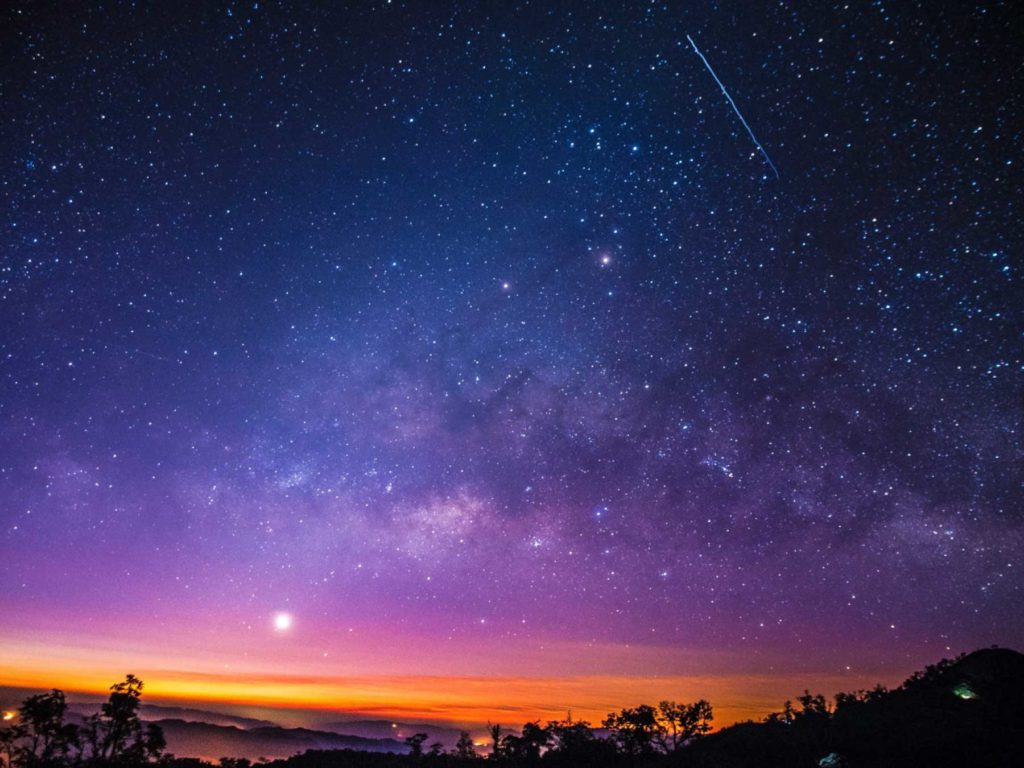
Dark Skies in Galena
One of the biggest obstacles for stargazing, and the bane of city-dwelling astronomers everywhere, is light pollution, which refers to excessive or misdirected artificial light that is emitted into the atmosphere. Streetlights, house lights, advertising signs, buildings and outdoor lighting fixtures can wreak havoc when it comes to observing the cosmos.
“Light pollution can drown out faint objects that you’re trying to see,” says Trentadue. “You need to get out of the city. Someplace dark.”
Dark sky compliance is becoming an increasingly popular trend in towns and smaller cities. The movement is aimed at preserving and protecting the quality of night skies by raising awareness about the adverse effects of excessive artificial lighting and promoting responsible lighting practices.
To become officially dark-sky compliant, communities reach out to the International Dark-Sky Association, a recognized authority on light pollution that provides resources and tools to industries, individuals and policymakers to help them reduce light pollution and promote responsible outdoor lighting. Communities can enforce policies in relation to architectural guidelines and outdoor lights to make sure they preserve the star-filled dark skies above them.
The Galena Territory, including the area around Eagle Ridge Resort & Spa, is now dark-sky compliant, and in 2021, this area east of Galena was named as a Dark Sky Friendly Development of Distinction Award recipient.
Zoran Perovanovich is a property owner in the Galena Territory, a member of the Galena Astronomical Society and the northwest Illinois representative of the International Dark Sky Association. He played an integral role in making the Galena Territory dark-sky compliant and making it eligible for the award.
“I moved to Galena Territory about seven years ago from Chicago,” he says. “I got involved in astronomy through the Adler Planetarium, where I did some stargazing, then switched over to Yerkes.”
When Perovanovich arrived in Galena, he began attending star parties held by the Galena Astronomical Society. He also became involved with the Galena Territory Architectural Committee, where he found like-minded members who were interested in the dark-sky initiative.
“The International Dark Sky Association is always looking for communities to certify if they follow certain parameters,” he says. “We achieved that on Feb. 13, 2021.”
The first step for Perovanovich and his team was to reach out to locals in the Galena area, convincing them that it would be beneficial to manage their light footprint.
“The dark sky category we fall under is Dark Sky Community,” says Perovanovich. “The specific certificate we received was the Dark Sky Friendly Development of Distinction.”
To maintain this distinction, homeowners in the Galena Territory keep their outside lights down from midnight until dawn, creating a dark atmosphere that allows the stars to shine brightly at night.
For stargazers outside the Galena Territory who are interested in joining the initiative, Perovanovich recommends heading to the International Dark Sky Association’s website and looking at the communities that are already compliant, including the dark sky section of the Galena Territory website.
“There’s quite a few,” he says. “See if there is anywhere close by and find out how they did it, so you can match the same thing.”
Getting in touch with a local association representative will also go a long way toward getting your community on the dark skies map.
“Those reps can explain to you what your options are,” explains Perovanovich.
Those options may vary, depending on where you live. Getting a big-box store across the street to turn off its lights is not easy, so Perovanovich advises keeping expectations realistic.
“There are things you can do and there are things you can’t,” he says. “In smaller towns and suburbs, it’s much more doable.”
The brightness of the night sky is measured using a nine-level numeric scale called the Bortle Scale, created by John E. Bortle. The lower the number, the darker the sky. Thanks to the hard work of Perovanovich and his colleagues, the Galena Territory’s night sky sits at a very viewable 3 on the scale. This allows stargazers in the territory to see many objects that wouldn’t be possible in cities with a higher number.
“Now you can see the Milky Way clearly,” says Perovanovich. “You can see the various stars and constellations, even with the naked eye.”

The J. Weiskopf Observatory
As part of the Byron Forest Preserve District, in Byron, the J. Weiskopf Observatory is open to the public for free viewing sessions with an experienced guide to the night sky.
“I’ve been interested in astronomy since I was 8 years old,” says Walter Trentadue, the observatory’s operator. “I worked at the Adler Planetarium for seven years and I was a police officer for 32 years. I kept doing astronomy through all of it.”

As someone who made his own telescopes and taught others about telescopes and seasonal constellations, Trentadue was an ideal candidate to install the observatory’s Celestron HD 1100 Edge telescope, which is mounted in the observatory’s dome. In addition to maintaining the telescope, he also helps visitors navigate it to specific areas of the night sky, so they can view the stars, moon and planets for themselves.
Vicki Funke is a field trip guide and observatory coordinator with the Byron Forest Preserve District and works closely with Trentadue during viewing sessions for school groups and the general public.
“You don’t have to sign up ahead of time, so we never know how many people are going to be here on a typical night,” she says. “Sometimes it’s nobody. Sometimes we’ll have 40 people.”
The observatory is open to the public year-round on Saturday evenings and every Tuesday evening from June to the end of August. The viewings begin a half-hour after sunset and run for about 3 hours, depending on viewing conditions and weather.
“You want a clear sky, obviously,” says Funke. “We’re open in winter unless it’s less than 20 degrees. The computer controls on the telescope don’t like it when it’s too cold. Neither do we.”
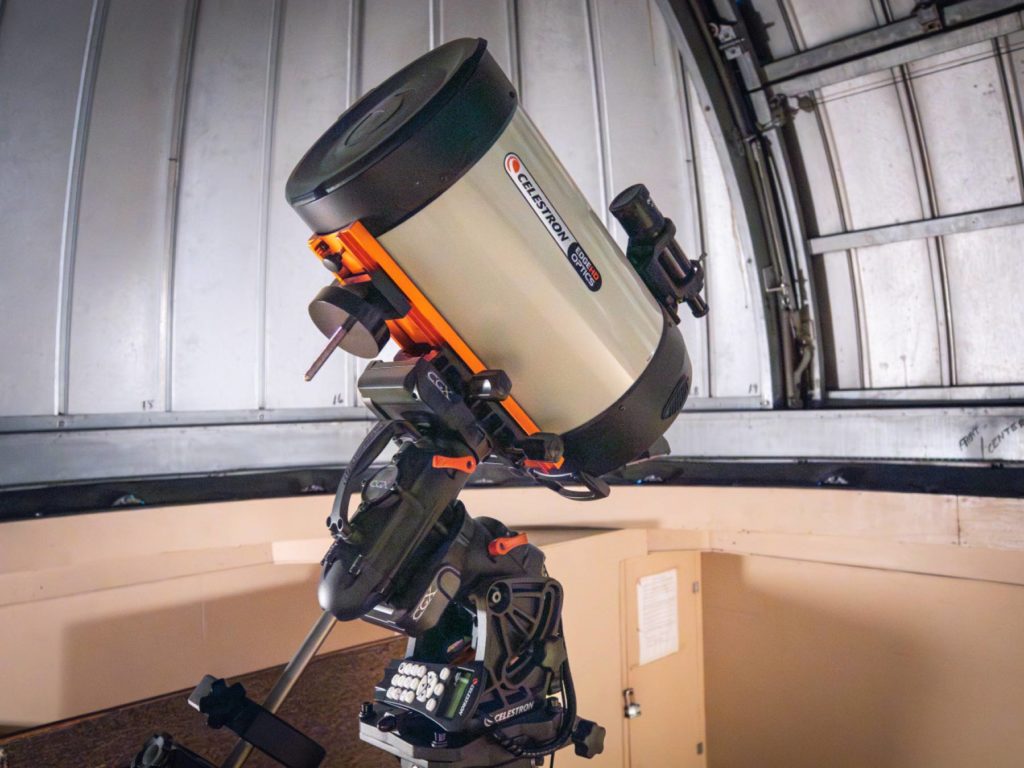
Visitors to the observatory will find a myriad of stargazing resources on the main floor, including a small library of books and walls full of star guides and celestial maps. A map of the moon is also prominently displayed, giving stargazers a detailed preview of what they will see once they view the moon through the telescope.
“The moon is something that both kids and adults relate to, so we like to look at it whenever it’s out,” says Trentadue. “We can bring it much closer so they can see the features, like the craters created by impacts with asteroids. The large basins are called ‘oceans’ or ‘seas’ because, when the ancients saw the darker areas, they assumed that was water.”
Another poster contains a visual guide of the Messier objects, a diverse set of 110 deep-sky objects that were catalogued by French astronomer Charles Messier in the late 1700s.
“That’s our prime target list,” says Trentadue, pointing to the Messier list. “The only way to become famous in astronomy was to discover a comet. Messier kept running into these objects that weren’t comets, so he compiled a list so they could be avoided while comet hunting. Ironically, that list made him famous.”
The telescope is just a short ladder climb away, housed in a dramatic dome that, when opened, slowly reveals the sky in all its splendor. From there, visitors can take a closer look at objects visible to the naked eye or look even further at objects in deep space.
“We can see the Andromeda Galaxy, and that’s 2.5 million light-years away,” says Funke.
One object that has been holding particular interest with astronomers lately is Betelgeuse, the brightest star in the Orion constellation. This red giant is an older star that is speculated to go supernova in the near future, but Trentadue and Funke suggest taking that news with a grain of space salt.
“The articles that say it will go supernova ‘any day now’ clearly aren’t written by astronomers,” says Trentadue.
‘“Any day now’ could be millions of years from now,” laughs Funke.
Planets are always on visitors’ must-see lists, and a glimpse through the telescope brings some of our solar system neighbors into sharp focus.
“You can see the rings on Saturn pretty easily. That’s everybody’s favorite,” says Funke. “One night, when I was here by myself, I saw the shadow of one of Jupiter’s moons going across its surface.”
There are thousands of objects that can be viewed through the telescope at the J. Weiskopf Observatory. A particular favorite of Funke’s favorites is globular clusters.
“They’re big groups of hundreds of thousands to millions of stars,” she says. “These are some of the oldest stars you can see, and they travel through space like a big globe or ball. They’re very impressive.”
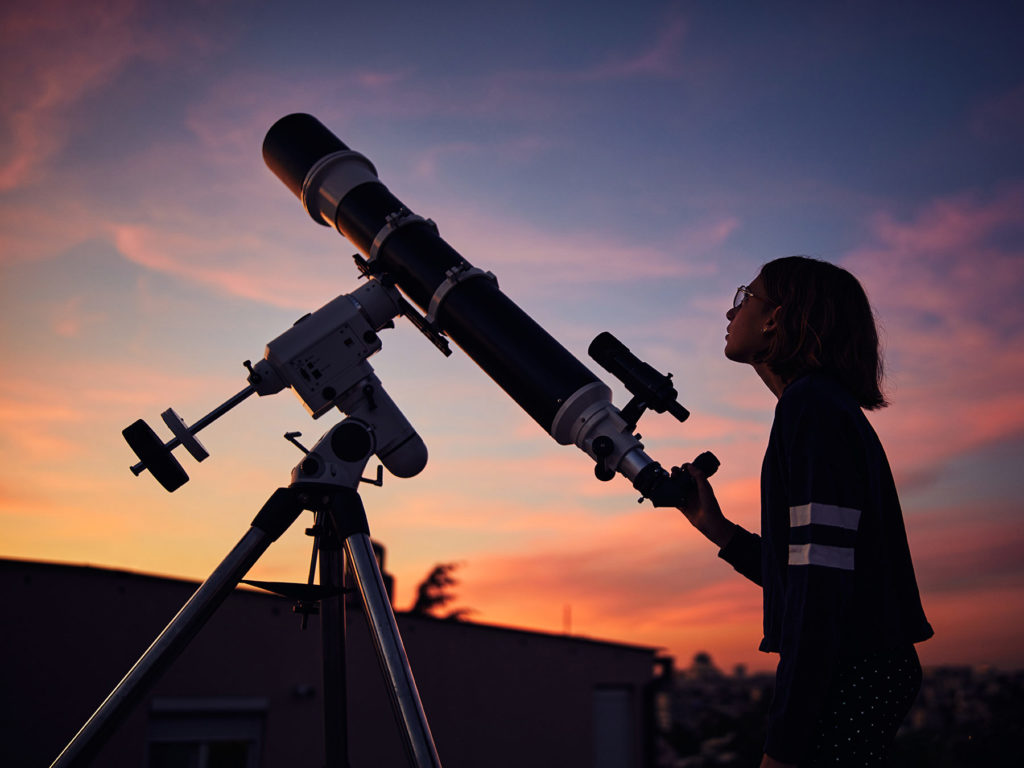
Tips for Stargazers
Stargazing is an immersive and fascinating hobby that anyone can do.
“The entire science of astronomy is designed for people to learn at their own pace,” says Trentadue, at the Weiskopf Observatory. “You don’t have to know a lot about the universe to get started.”
When it comes to tools, Trentadue suggests keeping it simple. Instead of breaking the bank on equipment, start with your naked eye and go from there.
“You can certainly see objects in the sky with your naked eye,” he says. “Binoculars are also a wonderful instrument.”
Trentadue playfully warns, however, that once you start using lenses, you won’t want to stop.
“It doesn’t matter what size telescope you have, you’ll always want something bigger,” he laughs. “That’s called aperture fever.”
When it’s time to move to the next step and buy a telescope, Trentadue cautions that you get what you pay for.
“If you’re going to spend money on a telescope, don’t buy a cheap one,” he says. “It will just end up in a closet collecting dust. You want a real telescope with a good mount.”
He also recommends going online or to a library for star maps and resources. The Peterson Field Guide to the Stars and Planets is a particular favorite.
“That’s my bible,” he says. “Everything you could want to know, especially if you’re starting out, is in that book.”
At the Yerkes Observatory, Bauer advises budding stargazers to look up their local astronomy organization.
“There are some people in those groups who are so knowledgeable and skilled,” she says. “They have a lot of really interesting equipment that you can learn about, especially if you’re thinking of buying something for yourself.”
She also recommends taking a few moments before stargazing to get your eyes adapted to the dark.
“Take 15 or 20 minutes to get used to the dark so your eyes can get used to faint light outside,” she says. “During this period, you shouldn’t look at your phone or bright lights. That really wipes out your ability to get adjusted to the night sky.”
In the Galena Territory, Perovanovich recommends seeking out a star party and arming yourself with knowledge.
“A lot of amateur astronomers are interested in bringing on new people,” he says. “They’re going to be available to mentor and assist you. If you go to a star party, there are people there who will help you get started.”
No matter how deep your interest lies, our region’s night sky has plenty of sights to discover and plenty of mysteries to unfold. Prepare to be amazed at what’s above.
Coming Soon to a Night Sky Near You
Any night is a good night to look for stars, constellations, planets and other objects in the night sky, but a meteor shower can be particularly exciting. Every year, the Perseid meteor shower makes an appearance, wowing stargazers with a spectacular show of what is commonly known as shooting stars.
“The Perseid meteor show peaks, this year, on Aug. 13,” says Dr. Amanda Bauer of Yerkes Observatory. “It’s a good opportunity to go out with a chair without binoculars or telescopes and see meteors going across the sky.”
The meteors are the remnants of the tail from Comet Swift-Tuttle, which passed close to Earth in 1992. While the peak occurs this year, many observatories and astronomy groups hold viewing parties over a few days.
Visitors to the J. Weiskopf Observatory can look for the Perseid meteors from August 11-13, starting at 8:30 p.m. until midnight. The telescope will be available for public viewing on Saturday evening.
“We do it on three different nights, in case we get clouded out,” says Vickie Funke. “People should bring reclining lawn chairs or blankets and dress for the weather.”
The nation’s biggest astronomy event in the next 12 months will be the total eclipse of the sun on April 8, 2024. For the best view of the eclipse, Zoran Perovanovich recommends heading about 300 miles south.
“Sometimes you have to travel a little bit to catch the marvels of the astronomical sky,” he says.


















































